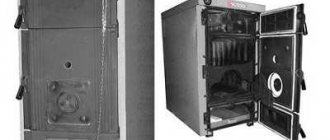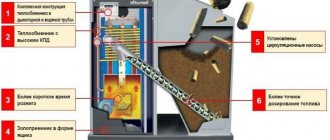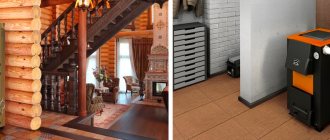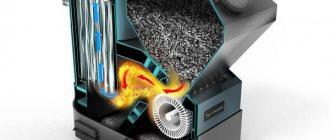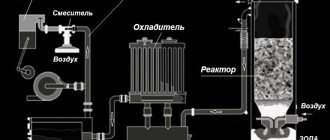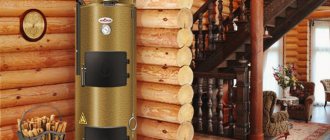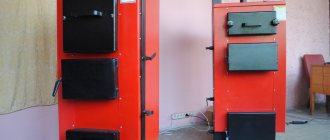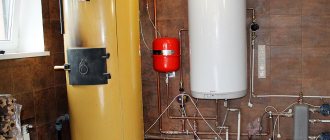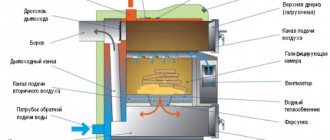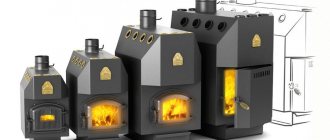Intensive suburban housing construction, which has been gaining momentum in recent years, is putting forward more and more new requirements for the types of heating equipment. The organization of autonomous heating, completely independent of centralized sources, confronts owners with a choice. As an alternative to gas water heating, solid fuel boilers are increasingly being used today. Modern models of such heating equipment have high technological characteristics and are economical. The only nuance that makes consumers think before choosing a heating device model is the need to frequently load heating equipment with fuel.
The practicality of heating equipment during operation plays for us, if not the main, then definitely a leading role. Gas boilers and electric heating devices are almost completely autonomous heating devices, while solid fuel boilers require constant human presence. The real way out of this situation would be to install a solid fuel boiler with a top-burning function in your own home. Let's take a closer look at what this type of heating device is and what the design features of the unit are.
Construction of solid fuel top combustion boilers
A top-combustion boiler unit belongs to the class of solid fuel heating devices, layer-type fuel combustion. The design of the firebox ensures long-term combustion of solid fuel, which means that daily maintenance of the top-burning boiler is not required.
Structural features - the internal volume of the vertical body is used as a firebox. It is designed in such a way that the combustion process of solid fuel proceeds from top to bottom.
This becomes possible due to the fact that air is supplied with a slight deficit directly into the combustion zone. Due to the lack of air, the process of smoldering of solid fuel occurs, and flammable gases are released from it.
They burn out in the upper part of the combustion chamber, releasing the maximum amount of heat. This organization of the combustion process increases heat transfer and reduces specific fuel consumption due to reduced heat loss due to chemical and mechanical underburning. The combustion chamber is divided into 2 parts by an air distributor shaped like a pipe.
On one side of it there is a platform with blades for turbulent air supply, and at the other end air enters. Top combustion boilers have cyclical fuel loading. Until the first fuel fill burns out, a new portion of coal or firewood cannot be added.
Furnace order
Before you start laying the stove yourself, complete a few simple preparatory steps.
First, soak the brick. To do this, the bricks need to be dipped in clean water and left there for about a day. Water will fill the pores in the brick structure. Thanks to this, the building material will not absorb water from the clay solution in the future.
Prepare a clay solution. It will consist of ground clay, some sand and clean water. The specific ratio of components is selected in accordance with the characteristics of the clay.
It is important that the finished solution has normal plasticity and a uniform structure. On average, it takes about 20 liters of mortar to lay hundreds of bricks
1 row. It was previously noted that this row should be laid out exclusively at the building level with additional checking using a square. Lay out this row in continuous masonry. Inside, it is allowed to use halves of bricks.
2nd row. Lay out in the same pattern as the 1st row. Be careful and do everything in strict accordance with technology, because... the first two rows serve as the base of the furnace, which should be as reliable as possible.
3-4 rows. Continue laying, gradually forming an ash chamber. At the same stage of masonry, the door of the mentioned chamber is installed. Additionally, 3 doors for cleaning hatches and a door for the blower are installed. Place smoke vents on the reverse side of the swede. They are placed in a vertical position and communicate with the combustion chamber through a hole created during the laying out of the furnace.
5 row. Install the finished oven and place a grate of suitable size in it. Form a cover for the cleaning hatches and the blower door.
6-10 row. Lay out the walls of the firebox and oven chamber. A partition made of fire-resistant brick is laid between the combustion compartment and the oven. The brick must be laid on edge. The partition should be a row lower than the chamber itself. After the tenth row is ready, lay a standard steel corner and an additional cast iron slab on the front of the structure. To secure the corner, use steel wire and a 2-centimeter layer of clay mortar.
11 row. Completely complete the closure of the channel through which the cast iron plate and the right wall of the furnace are separated.
12-16 row. Lay out the cooking compartment and 3 vertical flues. Lay out chimney openings from fire-resistant bricks.
17-18 row. Form an overlap over the cooking compartment. To form the ceiling, use the sheet steel laid in the previous stages and a corner made of the same material.
Row 19-20. Attach 2 hatches to the front of the door structure for cleaning the gas exhaust channels.
Rows 21-28. Lay out the chimney ducts. Don't forget to re-tie your stitches. In the process of laying out the 27th row, install a convenient latch. Above the installed smoke damper, leave a technological hole through which the gas ducts will interface with the air ducts.
Row 29-30. Lay out the overlap of the chimney ducts. At this stage, the width of the masonry around the perimeter must be increased by 50 mm. Thanks to this expansion, a cornice will be formed.
31 row. Adjust the dimensions of the overlap to the structural dimensions of the 27th row.
32 row. Start laying out the chimney. The standard chimney design has dimensions of 130x250 mm.
At this point, the laying out of the oven can be considered complete. At the end, all that remains is to complete the installation of the chimney, and also, if desired, to decorate the stove, for example, with paint or ceramic tiles. Additionally, you can buy a variety of accessories, for example, for storing fuel.
Shvedka stove (front view)
Building a staircase in a house is not an easy process, but it is doable. The main difficulty lies in calculating the angle of inclination and span parameters, because not only the ease of use, but also the durability of the structure depends on this. Durable and beautiful wood...
Where are they used?
Long-burning solid fuel boilers are used for heat supply to municipal, industrial, commercial and public facilities. The installation conditions for such modifications of heating boiler houses are much simpler than gas ones and do not require special permits.
However, they require the installation of a separate combustion and fuel storage room so that the coal or firewood is dry before being fed into the firebox.
To generate thermal energy, long-burning boilers can also use wood waste, briquettes and pellets.
Depending on the size of the firebox, fuel is added to the unit once a day, and some modifications once every 3 days. If there is a bunker fuel supply, the loading process can occur automatically. Boilers can provide not only the heating load, but also hot water supply with the inclusion of an external indirect heating boiler in the circuit.
Advantages and disadvantages
Modern long-burning stoves have a lot of advantages, which can play a decisive role in the initial selection of heating equipment. However, the disadvantages of existing designs require weighing the pros and cons before deciding to replace an existing heating unit with a newfangled pyrolysis boiler.
The advantages of the structures under consideration include:
- multiple increase in operating time on one fuel load;
- possibility of full autonomy - when entering the main mode, operation of the unit does not require operator intervention;
- the fuel burns with virtually no residue;
- the interval between downloads increases;
- using not only coal and firewood as fuel, but also wood chips, sawdust, dry plant waste, pellets, etc.;
- reduced weight and dimensions;
- possibility of adjusting the combustion process;
- The efficiency of long-burning pyrolysis boilers reaches 90%;
- smoke residues do not contain soot or harmful substances;
- many designs available for DIY.
Be sure to check out the disadvantages of this type of oven:
- increased requirements for the chimney. It must have sufficient height and thermal insulation;
- In long-burning furnaces, only dry fuel can be used. Excess moisture reduces the flame temperature, and water vapor blocks the access of oxygen, which makes it impossible for the unit to operate in gas generator mode;
- the reduced smoke temperature promotes the layering of soot and other combustion products on the walls of the chimney;
- when burning wet fuel, heavy fractions and dangerous chemical compounds appear in the smoke residues;
- higher cost compared to conventional furnaces.
If you weigh all the pros and cons, it is not difficult to understand that the wide popularity of long-burning stoves is not an accident at all, but the result of precise calculations and a carefully designed design.
Principle of operation
Increasing the duration of the combustion process is achieved not only by a large firebox. The organization of furnace combustion in the form of layered combustion with upper combustion and upper supply of blast air has a significant impact on efficiency and heat transfer, so gas-air flows do not circulate at all in the lower fuel layers.
Operating principle of a boiler unit with long-term combustion of solid fuel: The air required for fuel combustion is taken directly from the combustion chamber and passes through a preheating stage in the upper heating chamber of top-combustion boilers.
A pipe air distributor is built into the heating chamber to supply hot air to the combustion device. The feeding system can be gravitational or forced.
The air distributor is equipped with channels directed vertically. Before loading fuel, it is raised using a built-in mechanism, then fuel is poured in and the distributor, which rests on the upper fuel level, is lowered. As it burns out, it falls down the combustion space. This movement of the distributor provides air supply to the top layer of hot fuel.
In the contact zone of the air distributor with the fuel layer there is a steel disk - a staskoblin. Bypassing it, the fire enters the pyrolysis chamber located between the disk and the air heating chamber.
Here, flammable substances burn out completely, transferring heat through the walls of the firebox to the heating fluid circulating in the built-in heat exchanger. Flue gases are discharged through the gas outlet pipe into the chimney. The ash is collected in the ash box located at the bottom of the boiler unit, under the firebox. The volume of the box allows it to be cleaned at intervals of 2 to 5 loads.
Advantages and disadvantages
With all its undoubted advantages, a long-term combustion device with an afterburning chamber also has certain disadvantages. Before choosing the right model, we recommend that you familiarize yourself with the strengths and weaknesses of the equipment. This will help you settle on the best option.
The advantages of such units include the following:
- High efficiency is the main advantage of this type of furnace.
- Easy to maintain. If conventional units require frequent loading of fuel, then in the devices under consideration it burns very slowly, therefore the frequency of loading the flammable substance varies from 5 hours to 2 days.
- High efficiency.
- Large selection of models. Today, there are many similar ovens on the market of various shapes, sizes and power.
- Unpretentiousness in fuel. The equipment operates successfully on various types of flammable substances. Combination type ovens are also available for sale.
As for the shortcomings, the following are worth noting:
- The need for chimney insulation. This is a prerequisite for the normal operation of long-burning furnaces. The fact is that hot gases enter the channel from the combustion chambers. In cold weather, this causes immediate condensation to form, which quickly leads to soot accumulation and severe pipe blockage. In order for the stove to work properly, the chimney will have to be cleaned frequently.
- Need for customization. If the equipment is poorly adjusted, then the combustion of fuel in it will be incomplete, which will prevent the achievement of the main goal.
- High price. This disadvantage can be compensated, on the one hand, by independent production, and on the other, by significant fuel savings, thanks to which such a stove will quickly pay for itself.
Read more in Metal
How to choose a top combustion boiler
The model range of solid fuel top combustion boilers cannot be called wide, since their production is quite new and manufacturers of boiler equipment relatively recently began to produce such models. In practice, almost all modern models have similar designs.
When choosing a boiler brand, users should pay attention to particularly significant aspects:
- The material of the boiler heat exchanger is usually steel or cast iron. The first ones are installed in cheaper versions and are less durable for no more than 15 years. Cast iron options have a service life of over 25 years/
- The boiler operating efficiency and efficiency are selected as high as possible from the available range of 85-92%.
- Dependence on electricity, non-volatile units must be installed in areas with low reliability of electricity supply, and it must be taken into account that such boilers will operate with natural circulation through water and smoke exhaust.
- Fuel loading volume, good boilers provide loading once every 3-7 days.
Calculation of required heating power
Calculation of the thermal power of the boiler unit must cover all heat losses of the building with a margin of at least 20%. If the boiler must produce thermal energy to heat water, the power must accordingly increase in terms of the volume of water used in each specific case.
Calculating the heat loss of a building is quite complex; it depends on the climatic region of the facility’s location and the material of the walls and roof.
For an approximate calculation in the central region of Russia for houses with brickwork of at least 2 bricks and an interfloor height of 2.7 m, you can use the practical formula at the rate of 1 kW per 10 m2 of facility area with a margin of 20%.
For example, for a cottage with an area of 150 m2, the heating power of the boiler unit will be equal to:
150:10x1.2 = 18.0 kW
For a family of three, a domestic hot water tank of at least 100 liters with a power of 5.8 kW is required.
Thus, the total load on the boiler will be:
18.0 + 5.8 = 23.8 kW
The better way to heat
The most important advantage of using solid fuel boilers is their versatility in terms of fuel used: firewood, briquettes, pellets and coal.
When choosing a fuel, you need to proceed from its calorific value:
- coal, 15-25 MJ/kg;
- firewood, 15-17 MJ/kg;
- wood pellets 12-17 MJ/kg.
It is equally important when choosing fuel to take into account its combustion time in the firebox. When using firewood and briquettes, the average operating time of the boiler on one refill does not exceed 30 hours. At the same time, using pressed pellets, it is capable of heating a house for at least 72 hours.
High-tech automated coal-fired boilers can heat rooms for 5 days or even more, which significantly increases the practicality of using such units.
Today, combined modifications powered by both solid fuel and electric heating elements are especially popular.
Such thermal power equipment is characterized by practicality, versatility and easy operation. Firewood or coal is used as the base fuel, and in their absence, heating elements are turned on, which ensures the required temperature in the house.
Top 5 best models
In the trading network today you can find both relatively inexpensive and simple domestic boiler units, as well as fully functional automatic boilers from Western manufacturers of popular companies: Stropuva - a Lithuanian manufacturer, Buderus - a German boiler brand, WATTEK - a Czech boiler ACV - a Belgian manufacturer of boiler equipment and the Austrian brand Wirbel.
The most popular manufacturers of Russian companies producing long-burning boiler units are Magnum, Novosibirsk Metalworking Company, ZOTA, produced by the Krasnoyarskenergokomplekt company and Teplov Universal of the Kostroma plant.
Stropuva S 15 U
A small Lithuanian boiler with a thermal power of 15.0 kW, capable of heating a house up to 150 m2, is the best unit for heating small private houses. The S 15 U brand is versatile and can operate on any solid fuel.
The best characteristics of the boiler are ensured when using coal; when it is loaded into the combustion chamber of 217 liters, the boiler is capable of operating for 7 days with an efficiency of 86 to 90%, producing a coolant with a temperature of 75 C.
When working with firewood, you should use only dry wood to prevent the formation of tar on the walls of the firebox. The boiler has a mass of 205 kg and a service life of more than 10 years.
Price: 91,500 rub.
Liepsnele L20-U
Lithuanian boiler unit, with a more powerful unit of 20.0 kW, an analogue of Stropuva, with more advanced characteristics and therefore expensive equipment for the unit. It has the most voluminous firebox - 320 liters, and an efficiency almost equal to a gas boiler - up to 91%. The cast iron heat exchanger ensures a service life of up to 25 years.
Fuel versatility allows the use of any solid fuel, but the longest period of operation at 1 filling station, up to 7 days, is provided by coal. The maximum temperature of water leaving the boiler is 80 C.
The low working pressure of the hot medium, 1.5 atm, allows its use only in heating systems with natural coolant movement.
Price: 110,000 rub.
Galmet Top
Polish top combustion pyrolysis boiler with a thermal power of 20 kW, for heating a house with an area of 160-200 m2. This is a very modern universal modification with a 100% level of automation, a smart PID controller, an electric blower fan and weather-dependent automation.
The outlet temperature of the coolant is 55-80 C. The distinctive ability to control two heating circuits: warm floor + hot water, and also has a built-in recirculation pump.
Despite very high-quality thermal insulation, the manufacturer was unable to achieve high efficiency of the boiler; it does not exceed 87% for coal fuel. The heat exchanger is made of steel, so the service life is also not long - 15 years.
Price: 89,000 rub.
Week KO-60
A very popular model in Russia and the CIS countries with a name that is responsible for a week’s work from one load, while the chamber volume does not exceed 160 liters. The power is very high for such dimensions: peak 60 kW, and in long-burning mode 25 kW, controlled automatically and can heat an area of up to 350 m2.
The highest efficiency - 92% is achieved when using high-quality coal. This is also facilitated by the working control panel for the thermal processes of the Prond Proton 405.01 boiler and the WPA X2 blower fan to create pressurization of the boiler.
The heat exchanger and body of the unit are made of very thick combustion steel, which increases service life, although it leads to an increased weight of 420 kg.
Price: 130,000 rub.
Station wagon TA-40
Bottom combustion water heating boiler with top loading Teplov Universal 40 kW from the Kostroma plant has the ability to heat any residential and industrial premises up to 400 m2 with simultaneous preparation of hot water supply. The fuel boiler is universal, capable of operating on any solid fuel.
Automated or non-volatile unit layouts are available for sale. The efficiency of the boiler is not higher than 82% in manual mode; when using automation it exceeds 85%.
The boiler software is capable of maintaining the temperature in the house throughout the day, as well as distributing power according to the “heating - hot water” priorities in 4 modes. Price: 103,500 rub.
Do-it-yourself Swedish stove with three firing modes
Swedish stoves differ from other heating and cooking stoves by the presence of a heating panel in the rear part. This brick panel has a system of gas ducts: vertical or horizontal. The smoke passing through them heats up the structure, and from it the rooms are already heated. The system turns out to be efficient and economical: the heat that went into the chimney in a traditional Russian stove is used to heat the premises. But both shield construction systems (vertical and horizontal) have disadvantages.
With a horizontal arrangement of gas ducts, the entire shield is heated evenly. But such a system requires a large number of cleaning holes and, accordingly, doors on them. Considering that furnace casting is not cheap today, these doors significantly affect the final cost.
Heating panel of a Swedish stove with horizontal and vertical flue channels
If the gas ducts in the swedish are arranged vertically, there can be only one cleaning hatch. But there is another problem: while the stove is heating, in the first channel, on the side where the hot gases from the furnace enter, the shield will be noticeably hotter than in the third - at the exit. Since the shield is usually located in two rooms, one of them will be much warmer than the other.
There is also a third type of shield device: bell-type. It combines the advantages of both systems: one cleaning window is required, the entire surface is heated evenly, and less bricks are required for construction. Moreover, with this design, the oven cools down more slowly: the warmest air stays in the tops of the hoods for a long time, and the “draft” from the doors passes only through the center.
When using the bell-type principle of constructing the shield, heat is retained longer
From all that has been said above, it follows that the most economical and effective are Swedes with shields built on the bell-type principle. They are also easier to manage: it is possible to organize “summer” and “winter” operating modes, in which only a small part of the panel is switched on (in summer) or the entire heating power is turned on: in winter. There is even a version of a Swedish stove with three combustion modes: an “autumn” mode is added, in which a little more than half of the chimney channels are involved in the smoke circulation.
